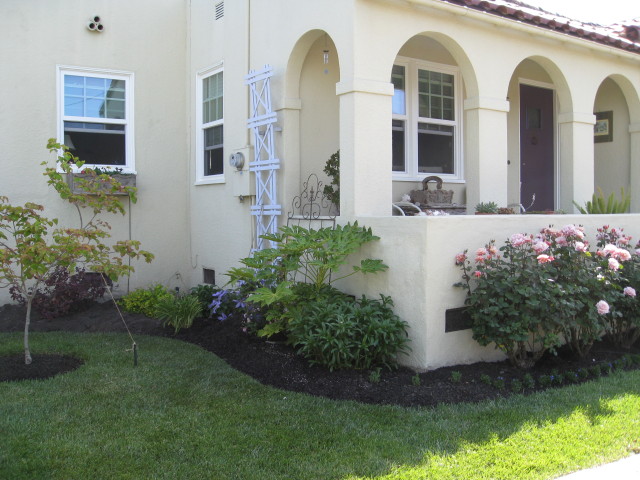Question
 My Garden
My Garden
Hello Sean:
I own an older stucco house built in 1939 of lath and plaster with a concrete foundation (unlike the newer-construction stuccos)on a small piece of property in sunny slightly inland Northern California where it is both warm and dry most of the year.
While you have answered a question similar to this, it was directed toward "raised beds" rising quite a distance off the ground. I think my question is different.
For many years there were no flower beds around the house by previous owners, but a few years ago we decided to wrap the house in 3-foot flower beds. Being a consciencious gardener, I have composted and mulched the beds and the plantings are established. In that time the soil level has risen to the top of the concrete foundation.
Although we have not detected as yet any rot or termites yet, and did not have the means at the time to do much about it, I now want to limit any damage to my house. I pulled away the soil from the house a little (about 4 to 6 inches), dug a trench about 8 inches down and now am wondering how to proceed. I have read that one needs to keep a 6-inch-deep clearance between soil and wood to prevent termites.
I have read that 16-mesh sand -- no smaller (they can carry it away)or no larger (they can bore through) -- is considered an effective deterrant to termites as they cannot bore through it, but I wonder if the sand retains moisture against the house. And I can't find anyone at all who carries this size sand particles.
I also thought to use pressure-treated 2x8 planks held in place using rebar against the bedding soil and filling in the trench between the house and garden bed with stones.
I would say that of the two potential problems -- termites or rot -- I am most concerned with rot. There are the old screened vents on the side of the house leading to the crawlspace which provides ventilation. But there is a portion of the house I can't get to underneath. A store employee suggested I spray all of the wood next to the concrete foundation through the vent openings with Copper Green which sounded like a good idea but this only addresses part of the problem, not the soil/stucco contact.
Another guy suggested I apply sticky-backed butyl rubber flashing as a moisture barrier and push the soil back against the wall.
I don't think I should just put the soil back against the stucco wall as it eventually will damage the stucco over time without some type of a barrier as there are some hairline cracks. Hopefully, you can provide me with some answers.
Thanking you in advance for all your kind help.
AnswerJane, the simple answer is you can not have soil against the plaster / stucco if wood is behind it at the same elevation. You should have a stucco contractor install a break at the terminus of the wood portion using a saw or what ever means needed. They can usually install some sort of joint Sorry i'm not an architect) before starting new stucco over the concrete foundation below. You need to make sure the soil and mulch are at least 3-4" below the plaster/stucco that is covering wood.
It appears you have a slope and can easily remove the soil needed. Note: If the plaster or stucco is not covering wood but concrete, then its fine to have dirt against it.
AS for your trench, thats not a good idea. With the slope you have just remove excess soil. If needed save the good stuff and dig out 6" below and then put the good stuff back. The rebar and Pressure treated wood could work also. But termites can move through any kind of aggregates...they deposit digested material and create little termite highways between the stones.
Best of Luck
Please take a look at my websites.
http://www.seanjmurphy.com
http://amenityarchitects.com
Sean J Murphy, LA, ISA, LEED AP
Director of Design
B+C Studio
http://www.bc-studio.net






